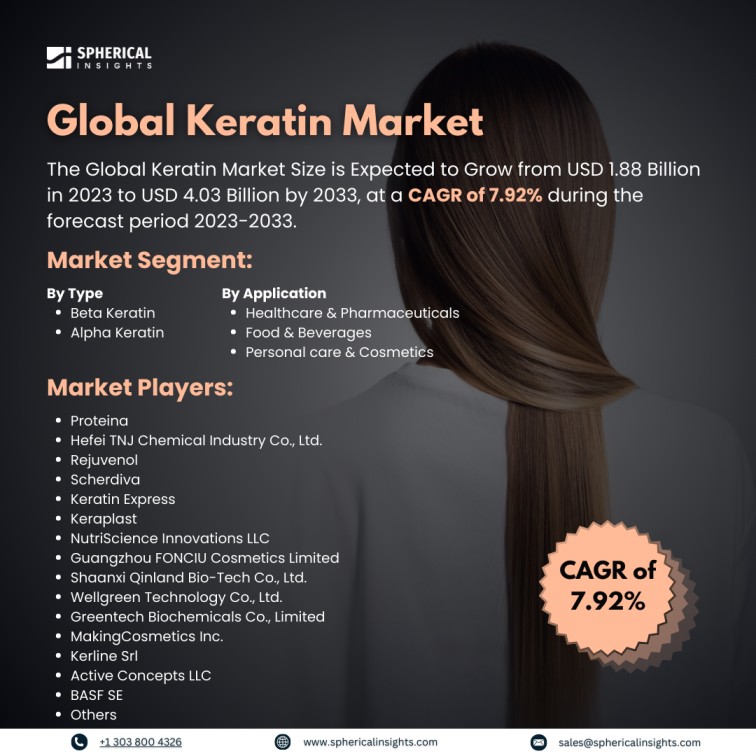Global Keratin Market Size to Exceed USD 4.03 Billion by 2033
According to a research report published by Spherical Insights & Consulting, the Global Keratin Market Size is Expected to Grow from USD 1.88 Billion in 2023 to USD 4.03 Billion by 2033, at a CAGR of 7.92% during the forecast period 2023-2033.
Browse 210 market data Tables and 45 Figures spread through 190 Pages and in-depth TOC on the Global Keratin Market Size, Share, and COVID-19 Impact Analysis, By Type (Beta Keratin, Alpha Keratin), By Application (Healthcare & Pharmaceuticals, Food & Beverages, Personal care & Cosmetics), and By Region (North America, Europe, Asia-Pacific, Latin America, Middle East, and Africa), Analysis and Forecast 2023 – 2033
Keratin is an industry that manufactures, distributes, and uses keratin, a fibrous structural protein found in hair, skin, nails, and animal fibresfibres. Keratin is widely used in cosmetics, personal care products, pharmaceuticals, and the food industry due to its strengthening, protective, and healing properties. It is also used in the manufacture of hair care products, such as shampoos, conditioners, and treatments meant to repair and strengthen hair. Moreover, increasing consumer demand for high-quality hair and skin care products drives the growth of Keratin, as Keratin strengthens and rejuvenates hair and skin. It is further supported by growing consumer consciousness towards natural and protein-rich ingredients for personal care products. Moreover, the popularity of keratin-based treatments and supplements for hair health increased the market size; advancement in biotechnology also supports the production of keratin at a larger scale. An increased concern for beauty and wellness also fosters this growth. However, the restraints to Keratin include high production costs, unavailability of raw material on a limited scale, and susceptibility to allergic reactions from products containing keratin. This market also comes with competition from other proteins and synthetic ingredients in personal care products.
The alpha keratin segment dominated the market in 2023 and is projected to grow at a CAGR during the projected timeframe.
Based on the type, the global keratin market is divided into beta keratin and alpha keratin. Among these, the alpha keratin segment dominated the market in 2023 and is projected to grow at a CAGR during the projected timeframe. This is due to its wide use in hair, skin, and nail care products because it is the main type of keratin present in human hair. The effectiveness of alpha keratin in terms of strengthening, moisture retention, and elasticity makes it the most popular for personal care formulation, hence dominant in the market.
The personal care & cosmetics segment accounted for the highest share in 2023 and is anticipated to grow at a remarkable CAGR during the projected timeframe.
Based on the application, the global keratin market is divided into healthcare & pharmaceuticals, food & beverages, and personal care & cosmetics. Among these, the personal care & cosmetics segment accounted for the highest share in 2023 and is anticipated to grow at a remarkable CAGR during the projected timeframe. The increasing demand for hair care treatments, skin care products, and anti-aging solutions is driving the growth of the market. The capacity of keratin to strengthen, hydrate, and repair hair, along with its high popularity in hair treatments and serums, has made it an essential ingredient in the beauty industry, driving rapid expansion.
North America is anticipated to hold the majority share of the global keratin market over the predicted timeframe.
North America is anticipated to hold the majority share of the global keratin market over the predicted timeframe. The region is well established with a personal care and cosmetics industry with high demand for premium hair and skincare products. Increased awareness of keratin benefits in consumer hair health and advancements in beauty treatments are factors propelling market growth. In addition, the growing demand for natural and protein-based ingredients in personal care supports North America's market leadership.
Asia Pacific is expected to grow at the fastest CAGR in the global keratin market during the forecast period. The growing beauty and personal care market in the region, especially in countries like China, India, and Japan, increases the demand for keratin-based hair and skincare products. Increased disposable incomes, growing awareness about hair health, and the rising popularity of premium beauty treatments and keratin-based products contribute to the rapid growth of the market in this region, making it a key area for expansion.
Competitive Analysis
Major vendors in the global keratin market are Proteina, Hefei TNJ Chemical Industry Co., Ltd., Rejuvenol, Scherdiva, Keratin Express, Keraplast, NutriScience Innovations LLC, Guangzhou FONCIU Cosmetics Limited, Shaanxi Qinland Bio-Tech Co., Ltd., Wellgreen Technology Co., Ltd., Greentech Biochemicals Co., Limited, MakingCosmetics Inc., Kerline Srl, Active Concepts LLC, BASF SE., and Others.
Key Target Audience
- Market Players
- Investors
- End-users
- Government Authorities
- Consulting and Research Firm
- Venture capitalists
- Value-Added Resellers (VARs)
Recent Development
- In December 2023, Unilever announced its agreement to acquire the premium biotech haircare brand K18. K18 is known for its innovative products, including the K18Peptide™, which mimics human keratin to repair hair damage quickly and effectively.
Market Segment
This study forecasts revenue at global, regional, and country levels from 2023 to 2033. Spherical Insights has segmented the global keratin market based on the below-mentioned segments:
Global Keratin Market, By Type
- Beta Keratin
- Alpha Keratin
Global Keratin Market, By Application
- Healthcare & Pharmaceuticals
- Food & Beverages
- Personal care & Cosmetics
Global Keratin Market, By Regional
- North America
- Europe
- Germany
- UK
- France
- Italy
- Spain
- Russia
- Rest of Europe
- Asia Pacific
- China
- Japan
- India
- South Korea
- Australia
- Rest of Asia Pacific
- South America
- Brazil
- Argentina
- Rest of South America
- Middle East & Africa
- UAE
- Saudi Arabia
- Qatar
- South Africa
- Rest of the Middle East & Africa



